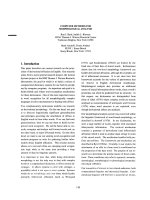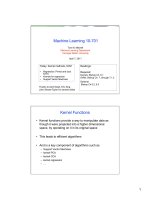kernel methods for pattern analysis
Bạn đang xem bản rút gọn của tài liệu. Xem và tải ngay bản đầy đủ của tài liệu tại đây (575.77 KB, 31 trang )
1
www.support-vector.net/nello.html
Kernel Methods for
Pattern Analysis
Nello Cristianini
UC Davis
www.support-vector.net/nello.html
In this talk…
Review the main ideas of kernel based learning
algorithms
(already seen some examples yesterday !)
Give examples of the diverse types of data and
applications they can handle:
Strings, sets and vectors…
Classification, pca, cca and clustering…
Present recent results on LEARNING KERNELS
(this is fun!)
2
www.support-vector.net/nello.html
Kernel Methods
rich family of ‘pattern analysis’ algorithms, whose best
known element is the Support Vector Machine
very general task: given a set of data (any form, not
necessarily vectors), find patterns (= any relations).
(Examples of relations: classifications, regressions,
principal directions, correlations, clusters, rankings,
etc.…)
(Examples of data: gene expression; protein sequences;
heterogeneous descriptions of genes; text and hypertext
documents; etc. etc.)
www.support-vector.net/nello.html
Basic Notation
Given a set X (the input set),
not necessarily a vector space…
And a set Y (the output set) eg Y={-1,+1}
Given a finite subset
(usually: iid from an unknown distribution)
Elements
Find a function y=f(x) that ‘fits’ the data
(minimizes some cost function, etc…)
)( YXS
×
⊆
)(),( YXSyx
ii
×
⊆
∈
3
www.support-vector.net/nello.html
The Main Idea:
Kernel Methods work by:
1-embedding data
in a vector space
2-looking for
(linear) relations in such
space
If map chosen suitably,
complex relations can be
simplified, and easily
detected
xx→
φ
()
www.support-vector.net/nello.html
Main Idea / two observations
1- Much of the geometry
of the data in the embedding
space (relative positions) is
contained in all pairwise inner
products*
We can work in that space by
specifying an inner product
function between points in it
(rather than their coordinates)
2- In many cases, inner
product in the embedding
space very cheap to compute
.
.
.
.<x1,xn><x1,x2><x1,x1>
<xn,xn><xn,x2><xn,x1>
<x2,xn><x2,x2><x2,x1>
* Inner products matrix
4
www.support-vector.net/nello.html
Example: Linear Discriminant
Data {x
i
} in vector space
X, divided into 2 classes
{-1,+1}
Find linear separation:
a hyperplane
(Eg: the perceptron)
0, =xw
www.support-vector.net/nello.html
Dual Representation
of Linear Functions
∑∑∑∑
∑∑
∑
∈∈⊥∈
⊥∈
∈
=+=+=
+=
==
Sx
jii
Sx
jii
Sspanx
jii
Sx
jiij
Sspanx
ii
Sx
ii
Sx
ii
iiii
ii
i
xxxxxxxxxf
xxw
xxxwxf
'0''')(
'')(
)(
)(
αααα
αα
α
The linear function f(x) can be written in this form
Without changing its behavior on the sample
See Wahba’s Representer’s Theorem for more considerations
5
www.support-vector.net/nello.html
Dual Representation
It only needs inner products between data
points (not their coordinates!
)
If I want to work in the embedding space
just need to know this:
x
x
→
φ
()
fx wx b yxx bii i() , ,=+
=
+
∑
α
wyxiii=
∑
α
Kx x x x(, ) (),( )12 1 2
=
φ
φ
Pardon my notation:
x,w vectors, α,yscalars
www.support-vector.net/nello.html
Kernels
Kx x x x(, ) (),( )12 1 2
=
φ
φ
Kernels are functions that return inner products between
the images of data points in some space.
By replacing inner products with kernels in linear algorithms,
we obtain very flexible representations
Choosing K is equivalent to choosing Φ (the embedding map)
Kernels can often be computed efficiently even for very high
dimensional spaces – see example
6
www.support-vector.net/nello.html
Classic Example
Polynomial Kernel
x
x
x
zzz
xz xz xz
xz xz xzxz
xx xx zz zz
xz
=
=
=+ =
=++ =
==
=
(, );
(, );
,( )
(,, ),(,, )
(),()
12
12
2
11 2 2
2
1
2
1
2
2
2
2
2
11 2 2
1
2
2
2
12
1
2
2
2
12
2
22
φφ
www.support-vector.net/nello.html
Can Learn Non-Linear Separations
By combining a simple linear discriminant algorithm with this simple
Kernel, we can learn nonlinear separations (efficiently).
∑
=
i
ii
xxKxf ),()(
α
7
www.support-vector.net/nello.html
More Important than Nonlinearity…
Can naturally work with general, non-vectorial,
data-types !
Kernels exist to embed sequences
(based on string matching or on HMMs; see: haussler; jaakkola and
haussler; bill noble; …)
Kernels for trees, graphs, general structures
Semantic Kernels for text, etc. etc.
Kernels based on generative models
(see phylogenetic kernels, by J.P. Vert)
www.support-vector.net/nello.html
The Point
More sophisticated
algorithms
* and kernels**
exist, than linear
discriminant and
polynomial kernels
The idea is the same:
modular systems,
a general purpose
learning module,
and a problem specific
kernel function
*PCA, CCA, ICA, RR, Fisher Discriminant, TDλ, etc. etc.
** string matching; HMM based; etc. etc
Learning
Module
Kernel
Function
∑
=
i
ii
xxKxf ),()(
α
8
www.support-vector.net/nello.html
Eg: Support Vector Machines
Maximal margin hyperplanes
in the embedding space
Margin: distance from nearest
point (while correctly
separating sample)
Problem of finding the optimal
hyperplane reduces to
Quadratic Programming
(convex !) once fixed the
kernel
Extensions exist to deal with
noise.
x
x
o
o
o
x
x
o
o
o
x
x
x
g
Large margin bias motivated by statistical considerations
(see Vapnik’s talk)
leads to a convex optimization problem (for learning α)
∑
=
i
ii
xxKxf ),()(
α
www.support-vector.net/nello.html
A QP Problem
(we will need dual later)
∑
∑
=
=
0
ii
iii
y
xyw
α
α
∑
∑∑
=
≥
−=
0
0
,
2
1
)(
,
ii
i
iji
jijijii
y
xxyyW
α
α
αααα
()
[]
0
1,,
2
1
≥
−+−
∑
i
iii
bxwyww
α
α
PRIMAL
DUAL
9
www.support-vector.net/nello.html
Support Vector Machines
No local minima:
(training = convex optimization)
Statistically well understood
Popular tool among practitioners
(introduced in COLT 1992, by Boser, Guyon, Vapnik)
State of the art in many applications…
www.support-vector.net/nello.html
Flexibility of SVMs…
This is a hyperplane!
(in some space)
10
www.support-vector.net/nello.html
Examples of Applications…
Remote protein homology detection…
(HMM based kernels; string matching kernels; …)
Text Categorization …
(vector space representation + various types of semantic
kernels; string matching kernels; …)
Gene Function Prediction, Transcription
Initiation Sites, etc. etc. …
www.support-vector.net/nello.html
Remarks
SVMs just an instance of the class of Kernel Methods
SVM-type algorithms proven to be resistant to v. high dimensionality
and v. large datasets
(eg: text: 15K dimensions; handwriting recognition: 60K points)
Other types of linear discriminant can be kernelized
(eg fisher, bayes, least squares, etc)
Other types of linear analysis (other than 2-class discrimination)
possible (eg PCA, CCA, novelty detection, etc)
Kernel representation: efficient way to deal with high dimensionality
Use well-understood linear methods in a non-linear way
Convexity, concentration results, guarantee computational and
statistical efficiency.
11
www.support-vector.net/nello.html
Kernel Methods
General class, interpolates between
statistical pattern recognition, neural
networks, splines, structural (syntactical)
pattern recognition, etc. etc
We will see some examples and open
problems…
www.support-vector.net/nello.html
Principal Components Analysis
Eigenvectors of the data in the embedding
space can be used to detect directions of
maximum variance
We can project data onto principal components
by solving a (dual) eigen-problem…
We can use this – for example – for visualization
of the embedding space: projecting data onto a
2-dim plane (will use this later)
12
www.support-vector.net/nello.html
Novelty Detection
Another QP
problem:
find smallest sphere
containing all the
data (in the
embedding space)
Similar: find small sphere
that contains a given
fraction of the points
•
•
•
•
•
•
•
•
•
•
•
www.support-vector.net/nello.html
Novelty Detection: example
10 20 30 40 50 60 70 80 90 100
10
20
30
40
50
60
70
80
90
100
QP
10 20 30 40 50 60 70 80 90 10
0
10
20
30
40
50
60
70
80
90
1
00
QP
13
www.support-vector.net/nello.html
Example 2
10 20 30 40 50 60 70 80 90 10
0
10
20
30
40
50
60
70
80
90
1
00
QP(linear)
10 20 30 40 50 60 70 80 90 10
0
10
20
30
40
50
60
70
80
90
1
00
QP
www.support-vector.net/nello.html
Effect of Kernels
10 20 30 40 50 60 70 80 90 100
10
20
30
40
50
60
70
80
90
100
QP(RBF)
10 20 30 40 50 60 70 80 90 100
10
20
30
40
50
60
70
80
90
100
QP
14
www.support-vector.net/nello.html
Smallest Sphere: Continued
This method can be used to define a class
of data (a subset of the input domain)
Eg: if defined over set of symbol
sequences, can be used to define/learn
formal languages (see next) …
(a task of syntactical pattern analysis)
www.support-vector.net/nello.html
A simple kernel for sequences
Consider a space with dimensions indexed by all possible
finite substrings from alphabet A.
Embedding: if a certain substring i is present once in
sequence s, then
φ
i
(s)=1
Inner product: counts common substrings
Exponentially many coordinates, but can compute the inner
product in such space in LINEAR time by using a
recursive relation
15
www.support-vector.net/nello.html
Sequence-Kernel-recursion
∑
=−+=
=Ω
i
i
atitsKtsKtsaK
sK
]])[1:1[,(),(),(
1),(
Where s,t are generic sequences, a is a generic symbol,
Ω
is the empty sequence, …
Analogous relation for K(s,ta) by symmetry…
Dynamic programming techniques evaluate this in linear
time !
It starts by computing kernels of small prefixes,
then uses them for larger prefixes, etc
www.support-vector.net/nello.html
Example
∑
=−+=
=Ω
i
i
atitsKtsKtsaK
sK
]])[1:1[,(),(),(
1),(
S=ABBCBBCA
T=BBABBCAB
Dynamic programming:
stored in table all the kernels for all smaller prefixes
The computation of the sum is just a matter of looking them up
16
www.support-vector.net/nello.html
More advanced sequence
kernels…
Compare substrings of length k, and tolerate
insertions …
Similar (but more complicated) recursions…
Demonstrated on sets of strings (generated by 2
different markov sources)
www.support-vector.net/nello.html
−1.2
−1
−0.8
−0.6
−0.4
−0.2
0
0.2
0.4
0.6
0.8
’MYZRHDCEUPSWOPJVCSFDU’
’DCXUSCVKEOPPZJJSAREQF’
’OSFDYCXZATCEVUAMYMHLJ’
’VJVEQQQQYMOKEOUPPPTCS’
’QFTXWXDBOUSSWWCXDYMOP’
’OYMVKEVWQBTSWQQXZAHHO’
’GGMHXNFDHOPTJVWKATPJI’
’WDJCEUSFDMYMRPTRYMOMR’
’HDJCEBATYCVZAHPPJVZAM’
’OUCEBTSHXLJKATYMHOYUP’
’NZSBHIKYRNJEWNMUWNJSN’
’LOXYOGEHHTVRDNYWNZSIQ’
’LIQWOZVKNTNYRULOSFPNI’
’FZUFPNJSGANTNBPLSBPCG’
’DDJJFJPRULOUQWNMTHIXK’
’WONMTVKAVFANMERHPCZIO’
’DDJDJEWOUQWDFAVRDJNTO’
’OGVKNMNNTOSDFRUFCVSZB’
’SGIXLLCYCTOULRHTOZIKN’
’AOUWBCGIXZBPLLIXRNNMU’
Plot of first two principal components
17
www.support-vector.net/nello.html
On detecting stable patterns…
We want relations that are not the effect of
chance
(i.e. that can be found in any random subset of
the data, whp)
Empirical processes results (see Vapnik’s talk)
can be used to guarantee this
We do not discuss this here
www.support-vector.net/nello.html
Practical Applications
Text Categorization:
semantic kernels, etc…
Bioinformatics:
gene function prediction; cancer type;
diagnosis…
18
www.support-vector.net/nello.html
More…
More advanced algorithms and kernels have
been proposed, to deal with very general types
of data, to insert domain knowledge, and to
detect very general types of relations (eg:
learning to rank phylogenetic trees; or detecting
correlations in bi-lingual text corpora; etc. etc.)
Now, however, we turn to another problem …
www.support-vector.net/nello.html
About Kernels…
Let S be a set of points x
i
Any function K(x,z) that creates
a symmetric, positive definite
matrix
K
ij=
K(x
i,
x
j
)
is a valid kernel
(= an inner product somewhere).
The kernel matrix contains all
the information produced by
the kernel+data, and is passed
on to the learning module
Completely specifies relative
positions of points in
embedding space
K(n,n)K(n,1)
K(i,j)
…
K(1,n)…K(1,1)
19
www.support-vector.net/nello.html
Valid Kernels
We can characterize kernel functions
We can also give simple closure properties
(kernel combination rules that preserve the
kernel property)
Simple example: K=K1+K2 is a kernel if K1 and
K2 are. Its features {φ
i
} are the union of their
features
A simple convex class of kernels:
(more general classes are possible)
Kernels form a cone
∑
=
i
ii
KK
λ
www.support-vector.net/nello.html
Last part of the talk…
All information needed by kernel-methods is in
the kernel matrix
Any kernel matrix corresponds to a specific
configuration of the data in the feature space
Usually a kernel function is used to obtain the
matrix – but not necessary!
We look at directly obtaining a kernel matrix
(without kernel function
)
20
www.support-vector.net/nello.html
The idea…
Any symmetric positive definite matrix specifies an
embedding of the data in some feature space
Cost functions can be defined to assess the quality of
a kernel matrix (wrt data)
(alignment; margin; margin + spectral properties; etc).
Semi-Definite Programming (SDP) deals with
optimizing over the cone of positive (semi) definite
matrices
If cost function is convex, the problem is convex
www.support-vector.net/nello.html
What is SDP ?
(semi-definite programming)
21
www.support-vector.net/nello.html
The Idea
Perform kernel selection
in “non-parametric” + convex way
We can handle only the transductive case
Interesting duality theory
Problem: high freedom, high risk of overfitting
Solutions: the usual …
(bounds – see yesterday - and common sense)
www.support-vector.net/nello.html
Learning the Kernel (Matrix)
We first need a measure of fitness of a kernel
This depends on the task:
we need a measure of agreement between a
kernel and the labels
Margin is one such measure
We will demonstrate the use of SDP on case of
hard margin SVMs. More general cases are
possible (
follow link below for paper).
22
www.support-vector.net/nello.html
Reminder:
QP for hard margin SVM classifiers
www.support-vector.net/nello.html
A Bound Involving Margin and Trace
(ignore the details in this talk…)
23
www.support-vector.net/nello.html
Optimal K: a convex problem
www.support-vector.net/nello.html
Just in case…
24
www.support-vector.net/nello.html
From Primal to Dual…
www.support-vector.net/nello.html
An SDP trick
Schur complement lemma
25
www.support-vector.net/nello.html
The SDP Constraint
www.support-vector.net/nello.html
SDP !
Maximizing Margin over K:
final (SDP) formulation









